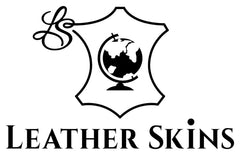When shopping for leather for a fashion, furniture, or manufacturing project, one of the most important—but often overlooked—factors is how the leather is tanned. Two of the most common tanning methods used in the leather industry are vegetable tanning and chrome tanning. Keep reading to learn about the difference between chrome tanned and vegetable tanned leather, common uses of each one, and the best place to shop for leather of all kinds.
Both veg tanning and chrome tanning processes produce durable, beautiful leathers, but they differ significantly in their application, characteristics, and appearance. Understanding these differences can help brands, designers, and manufacturers make more informed decisions when sourcing garment leather, upholstery leather, or leather for handbags and accessories.
What Is Vegetable Tanned Leather?
Vegetable tanning, often referred to as veg tan leather or veg tanned leather, is one of the oldest leather tanning methods known to humanity. The Sumerians, Etruscans, and Romans are all known to have used used vegetable tanning methods to produce leather. This traditional technique uses natural tannins extracted from tree bark, leaves, and other plant matter.
For centuries, vegetable tanning was done by digging a series of pits in the ground, and then these pits were filled with a slurry of water and ground plant materials. A hide would be placed in the first pit for a few days, and then would be removed, rinsed, and moved to the next pit to soak for a few more days. This process would be repeated numerous times over the course of weeks, with each subsequent pit bringing the leather closer to its final tanned state.

A slow process that's worth the wait
Veg tan leather is known for...
-
Natural appearance and earthy tones
-
Stiffness and durability that softens over time
-
Patina development, which gives each piece a unique look as it ages
-
Eco-friendliness, due to the use of natural materials
- Versatility of use, as it can be carved, stamped, and molded into almost any shape
Vegetable tanned leather for leathercraft and luxury goods
Vegetable tanned leather is especially popular for structured bags, western wear, belts, wallets, and high-end accessories where a natural look, long lifespan, and rich patina are desirable. It’s also used in some upholstery leather applications where durability and appearance are key.
However, because veg tan takes more time and resources to produce, it can be more expensive than leathers produced by other tanning methods. It’s also less water-resistant unless treated, making it less ideal for high-moisture environments.
Unique applications of vegetable tanned leather
While there are numerous shared applications for veg and chrome, vegetable tanned leather has a few applications for which chrome tan simply doesn't work. Veg tanned leather has more stiffness and structure than chrome tanned leather, so for example, if you're looking to create structured bags that stand up on their own, only veg tan will do. Similarly, if you're sourcing leather for sheaths, saddles, or holsters then it's likely you'll want to choose a nice heavy-weight vegetable tanned leather. Here's a few other applications that are unique to vegetable tanned leather:
- Leather tooling
- Leather stamping
- Leather carving
- Wet molding
- Burnishing
- Saddles and saddle bags
- Equestrian tack
- Gun holsters
- Gun belts

What is chrome tanned leather?
Chrome tanned leather is the most common type of leather today, accounting for roughly 80–90% of all leather production worldwide. In this process, leather hides are tanned using chromium salts, which significantly speeds up the production time—often completing the process in just a few days instead of weeks or months.
Chrome tanned leather is also highly durable, and less susceptible than veg tan to scratching or unwanted impressions. When veg tan leather gets wet, it soaks up the water like a sponge, becoming highly impressionable, almost clay-like—which is why its so good for stamping, tooling, and wet forming. Chrome tanned leather, on the other hand, is more water-resistant, and handles high temperatures (like the interior of a hot car) much better than veg tan. Chrome tan is also less likely to be darkened or discolored by direct sunlight, making it a good choice for apparel, furnishings, and upholstery.
That chrome tan leather smell
One of the most recognizable features of chrome tanned leather is the smell. While many types of vegetable tanned leather have a wonderful aroma, chrome tanned leather has that instantly recognizable "Wilson's Leather store" smell that wafted through the shopping malls of our youth. Chrome tan leather can also sometimes have slightly chemical scent, or even a mild "fishy" smell due to certain kinds of fish oil that are used in the chrome tanning process. However, the strong odors associated with chrome tanned leather are hardly a bad thing. The smell that leather gives off is a powerful sense reaction that can make a leather product more desirable than aesthetics alone.
Chrome tanned leather is known for...
- Softness and flexibility, making it perfect for apparel leather and garments production
- Vibrant color absorption, allowing for a wide range of dyed finishes
- Water resistance, making it suitable for outdoor wear or humid environments
- Scratch and impression resistance, making it more durable for high traffic areas
- Affordability, due to its fast and scalable production process

Chrome tan leather for garments and apparel
Chrome tanned leather is often used in the mass production of luxury goods, fashion garments, footwear, bags, and upholstery, particularly when a soft hand feel or drapey texture is preferred. Luxury leather is often chrome tanned, as it's the go-to choice for high-end fashions, luggage, handbags, and haute couture, where flexibility, comfort, and color customization are a must.
Chrome tanned leather for upholstery, home furnishings, and automotive
Thanks to its softness, durability, and resistance to moisture and stretching, chrome tan is a top choice for interior design leather. The versatility of chrome tanned leather makes it a popular choice for upholstery of all kinds, including sofas, ottomans, and decorative pillows, offering a supple texture and vibrant color options that complement a wide range of design aesthetics—from classic to contemporary. Chrome tan's ability to retain color and resist fading makes it ideal for high-traffic areas or sunlit rooms where longevity and appearance matter.
Beyond the home, chrome tan leather is also widely used as automotive upholstery leather, especially for car seats, steering wheels, gear shifts, and interior panels. The leather's flexibility and resilience allow it to withstand constant contact and fluctuating temperatures without cracking or losing its shape.

Comparison of veg tanned and chrome tanned leather
| Feature | Vegetable Tanned Leather | Chrome Tanned Leather |
|---|---|---|
| Tanning Time | Weeks | Days |
| Texture | Firm and structured | Soft and pliable |
| Aging | Develops rich patina | Retains original color |
| Color Range | Natural earthy tones | Wide variety of bright colors |
| Water Resistance | Limited (unless treated) | Naturally more water resistant |
| Cost | Higher due to time and labor | Lower due to fast production |
| Eco Impact | More eco-friendly | Requires careful chemical management |
| Best Uses | Belts, wallets, accessories, some garments and upholstery | Apparel, fashion garments, handbags, upholstery, footwear |
Chrome vs. veg tan: which leather is right for you?
Choosing between veg tan leather and chrome tan leather depends on your project's needs, budget, and values.
-
If you're producing high-end leather belts, briefcases, wallets, or accessories that benefit from a classic, rugged look and unique aging and patina, vegetable tanned leather might be your best bet. It's particularly well-suited for artisanal leather goods where both character and durability are paramount.
-
If you're sourcing leather for garments and apparel, luxury handbags, upholstery, or automotive accessories, or items where softness and color flexibility are important, chrome tan leather is ideal. It’s a go-to for fast fashion, modern upholstery, and apparel leather products that need to be soft, lightweight, and vibrant.

Sustainability of chrome tan vs. veg tan
When it comes to sustainability, vegetable tanned leather is always going to be the most sustainable tanning method, as it uses all natural plants, roots, bark, and wood pulp to treat the raw hides. Chromium salts and other chemical tanning agents, if not managed properly, can lead to pollution and health hazards for workers. However, while chrome-tanning has some drawbacks, the process is still much more environmentally healthy than chemical-heavy "vegan" leathers, which are made with harsh chemical pollutants like PVC and plastics.
Most leather tanned in the United States and Europe now employ responsible practices and treat their wastewater to reduce environmental impact. High-end tanneries hold themselves to a higher standard for sustainability, which is why it's important to choose leather from reputable vendors with transparent quality standards. Here at Leather Skins, we only source leather from reputable, ethical tanneries that prize sustainability.
Chrome-free leather
For designers and manufacturers concerned about sustainability, many tanneries now offer chrome-free leather, or hybrid tanning methods that reduce the environmental impact while maintaining some of the benefits of both processes. Leather Skins carries a selection of chrome-free leather that mimic the properties of chrome tanned leather, without the concern of environmental impact from harsh chemicals.

The best selection of chrome tan and veg tan leather
At Leather Skins, we offer a curated selection of both vegetable tanned and chrome tanned leather in a wide array of finishes, weights, and colors. Whether you're crafting a timeless belt, a premium handbag, or cutting-edge fashion apparel, we provide the highest quality garment leather, upholstery leather, footwear leather, and vegetable tanned leather to help bring your vision to life.
With years of experience in garment manufacturing and apparel production, we understand the unique demands of each tanning method and are happy to guide you in selecting the best leather for your next project.
Explore our full range at leatherskins.com and discover the difference real craftsmanship makes—no matter which tanning method you choose.





